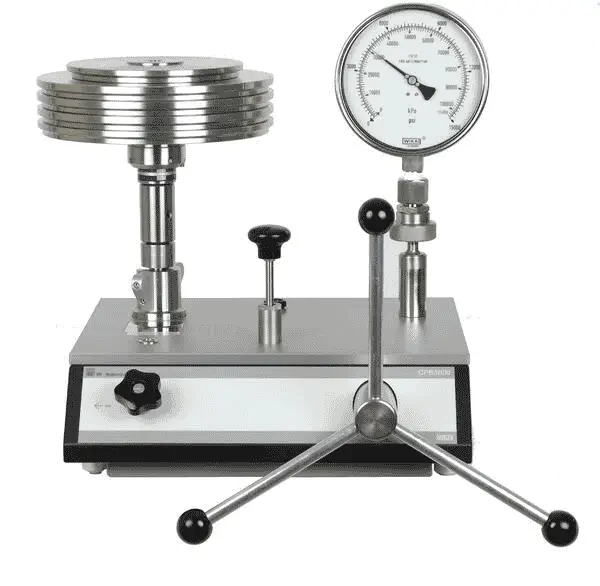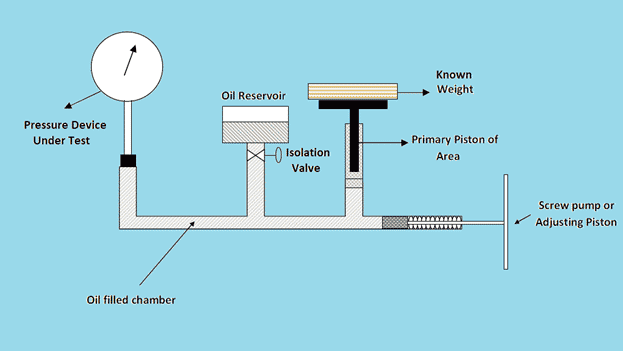In this article, we will discuss the working principle of a dead weight tester. Calibration of pressure sensing devices like pressure gauges, pressure transmitters, and pressure switches is very important in all plants. For scheduled maintenance such as pressure sensing devices, the validation of these devices is necessary at regular intervals.
Even during troubleshooting, many times we need to check the response of these devices. For this purpose, we are supposed to give pressure as an input for these devices to check their response. Many pressure-generating instruments like dead weight tester, pressure pump, Scandura, and hand pumps are available. Today in this article we will discuss the most common type of standard calibrating instrument which is a dead weight tester.

How does Dead Weight Tester Work?
A dead weight tester is a standard calibration instrument used in almost every industry for calibration purposes. Dead weight tester is mainly placed in laboratories or calibration centers of every industry. The dead weight tester works simply by comparing the pressure exerted by a known weight.
In a dead weight tester, a primary piston is present which carries a known weight, an oil reservoir chamber containing oil (oil is used because it is incompressible), an isolation valve for the oil reservoir, known weights with different magnitude, and a secondary piston to pressurize the oil filled in the chamber. This secondary piston is also called a pumping piston. A pressure gauge or a pressure transmitter or a pressure switch that is to be calibrated is installed on the place where we have shown a pressure device under test.

The pumping piston is used to pressurize the oil in the oil-filled reservoir. The weight starts floating after the application of a defined pressure which is proportional to the amount of the weight. There is a limit defined which can be seen visually between which the weight should start floating. Till the weight is not limiting, we have to keep on pumping or reduce the oil pressure. The weight on this piston has a particular defined pressure. An oil reservoir is also provided for filling the oil and an isolation valve for isolating the oil reservoir is also provided.
The scientific law behind the working of the dead weight tester is Pascal’s law which says that pressure applied in any closed container or the vessel is exerted equally on every part of the closed container or the vessel.
Pressure = Force / Area
The force is applied to the system using an adjusting piston. This adjusting piston transfers the force to the oil and oil transfers the force equal to the whole chamber. This equal distribution of oil is because of Pascal’s Law. Because of this, the weight starts floating and the same amount of pressure is seen on the pressure device.
The amount of piston pressure that can be produced by a deadweight piston is based on the weight of the piston. Deviation in the piston area can have a significant impact on the generated pressure also. Factors such as the force of gravity and the movement of the piston force and the temperature of the piston, as well as the pressure around the piston, affect the readings on the pressure gauge, a pressure transmitter, or a pressure switch. Also, large friction between the piston and the cylinder can cause measurement errors.
However, using high-quality materials in the production of the Dead weight tester and controlling certain environmental factors can reduce the chances of the error in the pressure reading, which leads to better pressure estimates.
Dead Weight Tester comes with a calibrator unit and can detect all ambient parameters and make real-time accuracy adjustments. An important advantage of using the dead weight tester is that it helps to accurately control and measure the pressure. Also, when it comes to measuring secondary pressure devices or measuring unknown pressure where a high level of accuracy is required, a dead weight tester provides the most accurate and least expensive solution.
Precautions
While using Dead Weight Tester make sure the following things are followed rigorously:
- Do not calibrate the pressure gauge or pressure transmitter or pressure switch which is to be used in the Oxygen service. Because here the test medium is oil and when oil comes in contact with oxygen, the result can cause an explosion.
- Before applying pressure through the adjusting piston, make sure complete isolation of the isolation valve for the oil reservoir. Else oil will come out of this oil reservoir.
- Use the same type of oil every time. Using different oil while refilling can cause any reaction or other problems of jamming
- Install the pressure gauge or pressure transmitter or pressure switch properly. Because of increasing the pressure, oil might come out from the connections with high pressure.
- Before using the dead weight tester, make sure that the dead weight tester is calibrated. If calibration is due, first calibrate the dead weight tester.